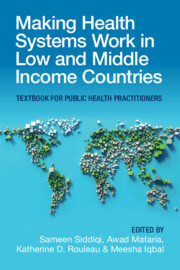 Making Health Systems Work in Low and Middle Income Countries
Making Health Systems Work in Low and Middle Income Countries Book contents
- Making Health Systems Work in Low and Middle Income Countries
- Reviews
- Making Health Systems Work in Low and Middle Income Countries
- Copyright page
- Dedication
- Contents
- About the Editors
- Contributors
- Preface
- Section 1 Analyzing Health Systems: Concepts, Components, Performance
- Section 2 Transforming Health Systems: Confronting Challenges, Seizing Opportunities
- Chapter 15 Universal Health Coverage and Beyond
- Chapter 16 Pro-Poor Expansion of Universal Health Coverage
- Chapter 17 Health Insurance for Advancing Universal Health Coverage
- Chapter 18 From Passive to Strategic Purchasing in Low and Middle Income Countries
- Chapter 19 Good Governance and Leadership for Better Health Systems
- Chapter 20 Developing a Balanced Health Workforce
- Chapter 21 Enhancing Equitable Access to Essential Medicines and Health Technologies
- Chapter 22 Health Information and Information Technology
- Chapter 23 Using Health Research for Evidence-Informed Decisions in Health Systems in L&MICs
- Chapter 24 Integrated People-Centered Health Care
- Chapter 25 Strengthening Hospital Governance and Management to Become High-Performing Organizations
- Chapter 26 Improving the Quality and Safety of Health Care in Low and Middle Income Countries
- Chapter 27 Harnessing the Contribution of the Private Health Care Sector toward Public Health Goals
- Chapter 28 Public–Private Partnership in Health Care Services
- Chapter 29 Embedding People’s Voice and Ensuring Participatory Governance
- Chapter 30 Achieving Health-Related Sustainable Development Goals
- Chapter 31 The Determinants of Health Systems
- Chapter 32 Integrating Essential Public Health Functions in Health Systems
- Chapter 33 Engaging in a Health Care Recovery Process
- Chapter 34 Health System Response to the COVID-19 Pandemic
- Chapter 35 Understanding the Global Health Architecture
- Chapter 36 Political Economy of Health Reforms in Low and Middle Income Countries
- Chapter 37 Better Health Systems for Better Outcomes
- Index
- References
Chapter 15 - Universal Health Coverage and Beyond
Health System Interventions and Intersectoral Policies
from Section 2 - Transforming Health Systems: Confronting Challenges, Seizing Opportunities
Published online by Cambridge University Press: 08 December 2022
- Making Health Systems Work in Low and Middle Income Countries
- Reviews
- Making Health Systems Work in Low and Middle Income Countries
- Copyright page
- Dedication
- Contents
- About the Editors
- Contributors
- Preface
- Section 1 Analyzing Health Systems: Concepts, Components, Performance
- Section 2 Transforming Health Systems: Confronting Challenges, Seizing Opportunities
- Chapter 15 Universal Health Coverage and Beyond
- Chapter 16 Pro-Poor Expansion of Universal Health Coverage
- Chapter 17 Health Insurance for Advancing Universal Health Coverage
- Chapter 18 From Passive to Strategic Purchasing in Low and Middle Income Countries
- Chapter 19 Good Governance and Leadership for Better Health Systems
- Chapter 20 Developing a Balanced Health Workforce
- Chapter 21 Enhancing Equitable Access to Essential Medicines and Health Technologies
- Chapter 22 Health Information and Information Technology
- Chapter 23 Using Health Research for Evidence-Informed Decisions in Health Systems in L&MICs
- Chapter 24 Integrated People-Centered Health Care
- Chapter 25 Strengthening Hospital Governance and Management to Become High-Performing Organizations
- Chapter 26 Improving the Quality and Safety of Health Care in Low and Middle Income Countries
- Chapter 27 Harnessing the Contribution of the Private Health Care Sector toward Public Health Goals
- Chapter 28 Public–Private Partnership in Health Care Services
- Chapter 29 Embedding People’s Voice and Ensuring Participatory Governance
- Chapter 30 Achieving Health-Related Sustainable Development Goals
- Chapter 31 The Determinants of Health Systems
- Chapter 32 Integrating Essential Public Health Functions in Health Systems
- Chapter 33 Engaging in a Health Care Recovery Process
- Chapter 34 Health System Response to the COVID-19 Pandemic
- Chapter 35 Understanding the Global Health Architecture
- Chapter 36 Political Economy of Health Reforms in Low and Middle Income Countries
- Chapter 37 Better Health Systems for Better Outcomes
- Index
- References
Summary
Health systems around the world share common goals, but attainment is widely variable. Universal Health Coverage (UHC) has emerged as a consolidated response to bridge the gap between what a health system should be doing and what it does. Drawing from global best evidence, this chapter explores how countries in practice could translate and achieve UHC, focusing on two central questions: What services and policies should be covered and be implemented; and second, how can health financing meet the UHC requirements? These include both health sector as well as intersectoral policies and interventions prioritized in the DCP3 package. The health sector interventions are distributed across four clusters – age-related, non-communicable disease and injury, Infectious diseases, and health services. The intersectoral interventions and policies fall under four domains – fiscal, regulatory, information and education, and built environment. The second question looks at the key challenges of country-level implementation capacity. It concludes by drawing out generalizable themes of country responses to the UHC Sustainable Development Goal targets to inform the way forward.
Keywords
- Type
- Chapter
- Information
- Making Health Systems Work in Low and Middle Income CountriesTextbook for Public Health Practitioners, pp. 225 - 240Publisher: Cambridge University PressPrint publication year: 2022
